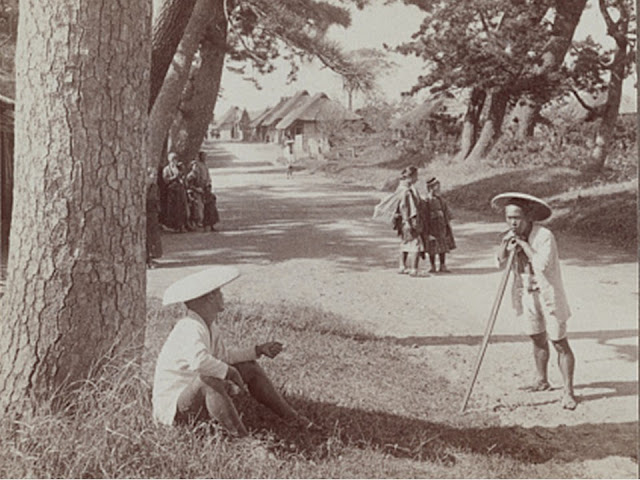Author : Miyamoto Tsuneichi(1907-1981)、著者:宮本常一
Fun during
nomadic life (2)、流離(さすら)いの中の楽しみ
(2)
Wayfarers resting under the pines at
Suzukawa - west along old post-road from Tokyo to Kyoto, Japan (1900-1910、東海道・富士市鈴川?) https://www.loc.gov/item/2020637826/
・Knowledgeable person、世間師(二)
The next knowledgeable person is Sakon Kumada who
lived in the south part of Osaka Prefecture. His face became ugly because he got
heavily burned during the Satsuma Rebellion (1877).
He was engaged in producing
freeze-dried tofu. After his wife passed away when he was fifty-two, he
retired; he started wandering when he was fifty-six. He liked traveling,
however he knew it was difficult to stay in a mountainous area. He met a
fortune-teller whose name was Ohkawa in Kyoto and he followed him.
Ohkawa walked around villages, because he might be able to help a person in
need. He was invited by customers by word of mouth. He was a good man; he asked
a customer for money which was necessary only to continue traveling.
Sakon went to Narita and Nikko which is
around 700km away from his village; he followed a monk in his village. However,
it was not interesting for him because of a trip on the train. I guess he had
little chances to talk with locals. He decided to follow Ohkawa again, and he
walked all around Kyushu Island when he was sixty-six.
The author wrote at the end of the
chapter that villagers in around 1900 knew what's going on in the world
through a knowledgeable person like Sakon. They had experiences to visit
and stay at various places, so their topics were interesting and enlightened
villagers. Nowadays, we can get many information easily from TVs and so on, therefore we
don’t need knowledgeable people so much; but we need wise people who we can
consult with.
次の世間師は、河内長野市滝畑の左近熊田翁です。翁は西南戦争では顔に大火傷をし醜い顔になってしまいました。
高野豆腐作りなどの仕事をしましたが、52歳で女房を失い、子供に跡を譲り、56歳から旅に出ました。旅好きな人ですが、山の中で暮らすといいことがないということで、京都で知り合った大川という八卦見について歩きました。大川さんは、困ったり苦しんだりしている人を、救えるかも知れないと思って村々を歩いている人です。コンサルタントの易者ですね。口コミで近郷に呼ばれて訪ねていきます。良くできた人で、見料は、旅を続ける分だけもらえれば十分という人でした。
翁は、村の坊さんについて成田と日光に行ったこともありましたが、汽車の旅でおもしろ味がなかったといいます。触れ合いが少ないのですね。また、大川さんと歩くことにし、66歳の時に九州を一回りしました。
著者は、明治から昭和の前半にかけて村々にいた世間師によって、村が世の動きについていけたと章を結んでいます。いろいろな場所で暮らした彼らの話は面白く、ヒントも多かったのでしょう。でも、「プロフェッショナル」や「人生の楽園」などのドキュメンタリー番組がたくさんあり、情報過多となった今では、世間師はなくなってしまいますね。だだし、物知り、知恵者などのコンサルタントは永遠に残るはずです。
・Women’s community、女の世間
Women in Suoh Ohshima, which is an
island where the author was born, went out to travel to know the world. The author
interviewed an old woman who traveled Shikoku Island (large island, 18,800
km²) with two of her friends when she was nineteen. It was a cheap trip.
In Uwajima which was a poor city, so a
house didn’t have a floor; it had a only earthen floor and straw mats. However,
residents welcomed travelers and let them stay at their home. She was proud
that she knew a lifestyle outside her island.
Luís Fróis (1532-1597), who was a missionary,
compared Japanese unmarried girls to European ones. In Europe, it was very
important to hold girls in house. In Japan, girls could go everywhere without permission
of their parents; they could go for any days. He also mentioned that even a
wife could go out anywhere without informing her husband of it. Luís Fróis’s findings
are written in a book of Amino Yoshihiko, “Reading ‘The Forgotten Japanese’”. Women
were free even in the 16th century.
The interviewee looked forward to
joining women who came from Kyushu Island on the way. She said that someone
found her husband during a trip and someone adopted a local child. It was a
slow and long trip on foot. Aside from that, it was a poor and difficult time;
people sought for a family to adopt their children, or people sought for a
child while traveling. It's difficult to believe those happened only a hundred
years before.
A pilgrim band on Nikko's street, Japan (1896)、日光巡礼者 https://www.loc.gov/item/2020634064/
周防大島の女性たちも世間を知るために旅に出ました。19歳の時に三人で四国へ貧乏旅行した話を老婆から聞き取っています。宇和島は貧しくて、床がなく土間にむしろを敷いた家が多かったのですが、快く泊めてくれました。島の外の知識は誇りになりました。
彼女は、九州などからきた旅人たちと道連れになることが楽しみで、また、旅で夫が見つかる人、もらい子をする人もいると答えました。歩いて回るゆっくりした旅ならですね。それにしても、生活が苦しいとはいえ、子供を連れて預かってくれる家を探したり、旅人に子供を委ねたり、大変な時代です。
Previous post (Part3 of this article, Fun of nomadic
life(1)、さすらいの中の楽しみ(1)): The
Forgotten Japanese (published in 1960 )(3/6)、忘れられた日本人 part3
Next post (Part5 of this article, Lovemaking、男女間の楽しみ): The
Forgotten Japanese (published in 1960 )(5/6)、忘れられた日本人
part5



Comments
Post a Comment